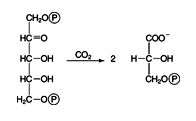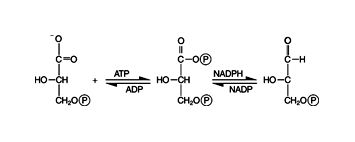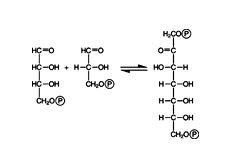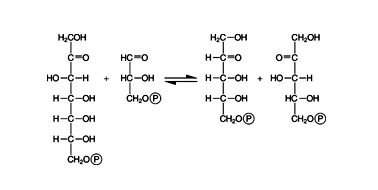This pathway is sometimes called the Calvin‐Benson cycle, after the biochemists who elucidated it. The 5‐carbon, doubly phosphorylated carbohydrate, ribulose bisphosphate is the acceptor for CO 2; the enzyme is called ribulose‐bisphosphate carboxylase/oxygenase (called Rubisco).

The initial product of the reaction is unstable and quickly falls apart to yield two molecules of 3‐phosphoglycerate.
The rest of the Calvin cycle is involved in interconversion of carbohydrates to make glucose (or starch) and the regeneration of the ribulose‐bisphosphate acceptor. The reactions are also found in the pathways for gluconeogenesis and the pentose phosphate shunt. The first step is the phosphorylation of 3‐phosphoglycerate by the same reactions involved in gluconeogenesis.


![]()
The glyceraldehyde‐3‐phosphate can be converted into the 6‐carbon sugar phosphate called fructose‐6‐phosphate by the reactions of triose phosphate isomerase, aldolase, and fructose bisphosphase.
|

Note that the last step is irreversible, just as it is in gluconeogenesis.
In shorthand, the reactions to this point are:

Regeneration of ribulose bisphosphate occurs by the same reactions that occur in the hexose‐monophosphate shunt. The hexose monophosphate shunt interconverts 3‐, 4‐, 5‐, 6‐ and 7‐carbon sugar phosphates. In the formation of one molecule of glucose from CO 2, carrying out the previous reactions six times is necessary. Making the six molecules of ribulose‐bisphosphate required for fixing six CO 2’s occurs by the following sets of reactions:
- Reaction 1: Transketolase transfers a 2‐carbon unit


- Reaction 2: Transaldolase transfers a 3‐carbon unit


- Reaction 3: Transketolase transfers a 2‐carbon unit
![]()
![]()


![]()
Remembering all these reactions can be difficult. Thankfully, a useful mnemonic exists to help you keep track of the number of carbons in each of the three reactions:

The 5‐carbon sugar phosphates are interconverted by the action of epimerase and isomerase to yield ribulose‐5‐phosphate, which is phosphorylated by the enzyme ribulose phosphate kinase to make RuBP, the acceptor of CO 2.
Ribulose phosphate kinase is active only when a cystine disulfide on the enzyme is reduced to two cysteines. An electron carrier, thioredoxin, carries out this reduction, and is then itself reduced by electrons from NADPH. Because the action of Photosystems I and II forms NADPH, this reduction ensures that ribulose bisphosphate is made only when enough light exists to support Photosynthesis. In other words, the light and dark reactions are coupled.